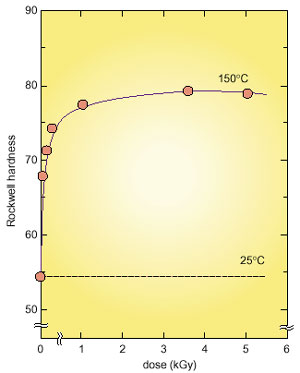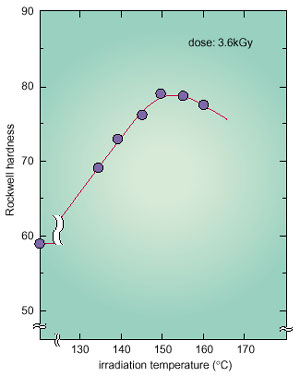Polycarbonate (PC) and aromatic polysulfone (PSF) are well known as engineering plastics used for industrial products such as gears and impellers for chemical pumps. By increasing the surface hardness, these materials may be applied to high performance machinery parts and medical devices. Studies of radiation effects on polymer materials so far have shown that these are sharply influenced by irradiation temperature. For the purpose of improving the hardness of PC and PSF, the effects of irradiation temperature (i.e., from ambient temperature to 230 degrees cent.) were studied for both gamma-ray and electron beam irradiations.
As shown in Fig. 9-3, Rockwell hardness increases with irradiation up to 5 kGy at 150 degrees cent. Figure 9-4 shows the relation between hardness and temperature during g irradiation with a dose of 3. 6 kGy. The irradiation temperature giving maximum hardness is 150 degrees cent., which corresponds to the glass transition temperature of PC. Moreover, it has been found that resistance to wear improves by about 30% with irradiation at high temperature. For the case of PSF, the hardness also increases markedly with a radiation dose of 3 - 4 kGy and approaches a maximum at a temperature near its glass transition temperature (178 degrees cent.). With electron beam irradiation, for which the irradiation time can be shortened extremely, results similar to those shown in Figures 9-3 and 9-4 were obtained. It has been demonstrated with other experiments that the process of chain scission proceeds preferentially compared with cross-linking in these polymers. The reasons for increased hardness and improvement of resistance to wear can be interpreted in terms of molecular rearrangement in the PC and PSF matrices which occur as simultaneous irradiation-induced chain scission and annealing at the glass transition temperature which produces tight packing of the chains.
Hitherto, for practical application of the hardened engineering plastic, fillers such as ceramic powder and glass fiber tips have been mixed into polymers. These methods may produce severe damage to materials that these plastics come into contact with, and deleterious effects on the environment from the standpoint of waste disposal. The technique presented here to enhance hardness and wear resistance through high temperature irradiation is a new and useful modification process for polymer materials which avoids the harmful effects of conventional methods. |


